If there is one thing I love about a city is having the option to live "car free", Sao Paulo and Rio de Janeiro in Brazil are definitely cities I know you can live without a car, and my biggest surprise was reading Meredith's Blog and finding out Brasilia can also be a "car free" city, I didn't even knew they had a subway system.
I have heard Belo Horizonte, Porto Alegre are also pedestrian friendly and Curitiba is supposed to be one of the best, and actually a model for smart urban planning copied around the world.
America's Most Walkable Cities, 2011
August 3, 2011
Living within a quick drive of work, the store, school or public transportation is nice, but only having all of those items a few blocks away makes your neighborhood "walkable."
The people behind Walk Score, a Seattle-based service that rates the convenience and transit access of 10,000 neighborhoods in 2,500 cities, have spent the past four years judging the distance between residents and amenities and ranking places based on the results. That "walkability" led to the first set of rankings in 2008 and the use of those rankings by more than 10,000 cities, civic organizations and real estate groups in the years that followed.
Walk Score's ideal neighborhoods have either a main street or public space at the center, enough people to keep public transit running frequently and a good mix of housing and businesses. Parks and other public spaces make up a large part of the equation, as do amenities designed around pedestrians, nearby schools and workplaces and "complete streets" designed for pedestrians, cyclists and transit.
"Very often, you'll see a good pedestrian design with sidewalks and crosswalks that make a city more accessible and walkable," says Josh Herst, chief executive of Walk Score. "Even in cities that on the whole aren't that walkable, there are neighborhoods that are great places to walk."
A CEOs For Cities study based on Walk Score data insists that a walkable neighborhood adds an average $3,000 to a home's selling price. And University of British Columbia professor Lawrence Frank found that residents of walkable neighborhoods tend to be at least seven pounds lighter than their counterparts in more sprawling areas.
Here's a look at Walk Score's Most Walkable Cities of 2011 and the amenity-packed neighborhoods that made the difference:
5. Philadelphia
Walk Score: 74.1
Any tourist who's seen Independence Hall and stopped into a Wawa for Tastykakes and directions can tell you that the city's most walkable neighborhoods in Center City, the Old City and along the riverfront near Penn's Landing are some of the easiest to navigate in the country. What locals probably won't tell the average cheesesteak-chomping out-of-towner is just how easy it is to get around South Philly and its surrounding neighborhoods.
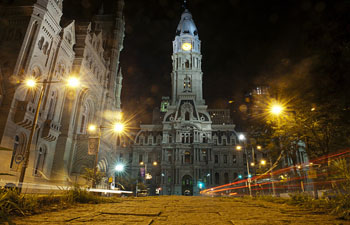 |
| Philadelphia City Hall in America's 5th most walkable city. Photo: flickr | bengrey |
Except for the extreme northeast, southwest and northwest corners of the city, much of Philadelphia's fairly easy to get around. About 95% of the city is easily accessible by means other than a car, but it's just a matter of doing so.
There's no shortage of cars in this town, and the city's conflicted relationship with the Southeastern Pennsylvania Transit Authority may have something to do with it. Septa's bus, subway, light rail and commuter rail services handled 327.6 million passengers this year, including travelers taking the airport line right into Center City. That's great and all, but it's still less than the ridership of a Boston MBTA that covers a city nearly one-third Philadelphia's size.
4. Chicago
Walk Score: 74.3
The city's broad shoulders aren't nearly as important as its broad sidewalks and bus and subway options when it comes to walkability.
The city's restaurants, theaters, shops and other amenities are closer and more accessible the nearer one gets to Lake Michigan. Lake View and Wrigleyville or West Town and Wicker Park are great place for living car free. Stray too far west or south, however, and you'll end up in the 4% of Chicago neighborhoods that need an automotive assist.
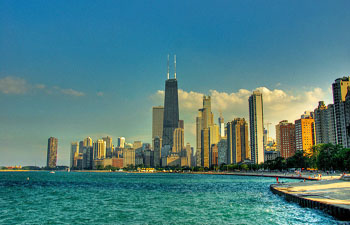 |
| Chicago skyline in America's 4th most walkable city. Photo: flickr | Bryce_edwards |
The Chicago Transit Authority helps level the extremely wide playing field with buses and trains that helped roughly 515 million riders get through the city last year. That includes the throngs of tourists and business travelers flying into O'Hare and Midway and taking CTA trains into the city. Another 70.5 million riders who take the commuter rail in from the suburbs each day make a strong argument to keep the car under wraps until the snow stops falling.
The town can still be a mixed bag when it comes to getting around, however. If you're barhopping or looking for good Italian beef in Old Town, Lincoln Park or Near North Side, you won't have to stray far. If you're trying to make it to a play in Pilsen after a barbecue in New City, however, it's a crapshoot.
3. Boston
Walk Score: 79.2
Residents of the Back Bay, Beacon Hill, the South End and Fenway who feel they weren't built for cars can sleep soundly knowing their neighborhoods weren't either.
It's easy to get to just about any point in this city without ever sitting behind the wheel of a car because the city's first residents needed it to be that way. The winding streets Mayor Thomas Menino calls "cow paths" were often just that. The city's Colonial-era survival was based on its density, residents' proximity to goods and services and the ability to get those goods home without carrying them a great distance.
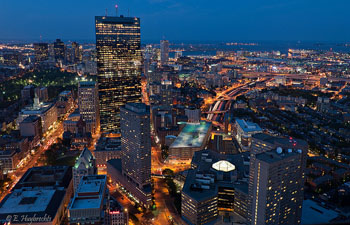 |
| Boston skyline in America's 3rd most walkable city. Photo: flickr | Manu_H |
"Cities that were largely built in World War II and post-World War II were built with the car at the center of them," Herst says. "When you think about cities like Boston and New York City, at least at the center of them, they were built into meaningful metropolises before the car."
The oldest subway system in America has helped make it easier for Bostonians to get from place to place, but T riders disenchanted with the aging system might prefer pulling cattle. The Massachusetts Bay Transportation Authority moved more than 373 million riders through its light rail, commuter rail, ferries and buses last year, with 149 million of those riders taking a subway that has had portions running since 1897.
2. San Francisco
Walk Score: 84.9
Walk Score considered it the most walkable city in America back in 2008 and it probably still would be if more New Yorkers weren't paying exorbitant sums for shoeboxes in SoHo or "lofts" with a few hundred feet on the Lower East Side.
There hasn't been a whole lot of change since then, which is just how residents who've tried to minimize car-related change like it. San Francisco's compact, concise layout didn't take the car into consideration when it was incorporated in 1850 or after it was rebuilt following the 1906 earthquake. Even while the rest of America was having a love affair with the car during the 1950s, local protesters were busy stopping freeways from running through town.
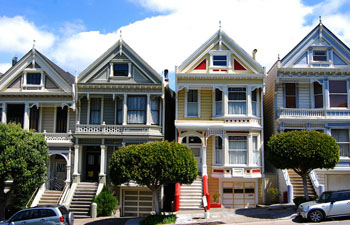 |
| S.F.'s 'Painted Ladies' in America's 2nd most walkable city. Photo: flickr | Paul Lowry |
As a result, 17 of its neighborhoods rank among the top 150 most walkable in the country, with Chinatown and the Financial District sitting behind only New York's TriBeCa, SoHo and Little Italy. Only 1% of the city lives in areas dependent on cars.
This has made the city's mass transit especially vital. Despite the expense and lack of deals for monthly passes, the Bay Area Rapid Transit subway system carried more than 100 million passengers last year and the San Francisco Municipal Railway took on another 209.5 million. That doesn't include other commuter rail and bus service from Silicon Valley and elsewhere that added more than 20 million riders to the mix. San Francisco might want to consider clamoring for a walkability recount.
"The margin is very small," Herst says. "Both cities are very walkable and we're calling on our community to vote for the city they think is more walkable to help break the virtual tie."
1. New York
Walk Score: 85.3
Manhattan's 16 miles long and two miles wide and has been walkable since the days when the only other transportation option involved an animal. Densely packed areas such as Brooklyn's Fort Green, Park Slope and Carroll Gardens and Bay Ridge, Queens' Sunnyside and Astoria/Long Island City and the South Bronx, University Heights and Fordham neighborhoods in the Bronx are giving Manhattan a run for the money thanks to tightly packed areas that are only increasing in density.
"New York's narrow move past San Francisco in the 2011 ranking is largely a result of updated census data," Herst says. "There are more people living in more walkable neighborhoods in New York."
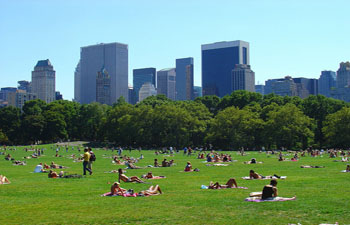 |
| N.Y.'s Central Park in America's most walkable city. Photo: flickr | ZeroOne |
The Metropolitan Transit Authority is feeling every bit of that growth, too. Last year, the MTA moved more than 3.2 billion riders with its buses and subways, with more than two-thirds of that total riding the rails. That doesn't even count the 81 million commuter rail riders taking the Metro-North, another 95 million on the Long Island Railroad, 4.3 million on the Staten Island Railway and millions more coming in on New Jersey trains.
Not only is the overwhelming majority of New York eminently walkable, but only 2% of all New Yorkers live in neighborhoods that require owning a car.
5 comments:
I hear you Meredith.
Before reading your posts, I was under the impression that Brasilia was like Los Angeles or Dallas, where not having a car is absolutely not an option.
But it's great to hear people can have "car free" lives in Brasilia as well.
Ray
Rio is very walkable... well, more like walkable with good public transporation. Before kids we didn't have a car and really didn't need one. Now it's a convenience thing.
Rachel,
I love Rio, it is an awesome cosmopolitan city, and I am sure a car is cool to allow you to take those great scenic drives in the mountains nearby. ;)
Ray
Love this! I am not a fan of city driving, so I tend to migrate to walkable cities. I've lived on two on the list - highly recommend both Chicago and NYC for walking visitor or transplants.
B.A.B,
I don't like driving PERIOD, in the city or in the country, so for me, walkable cities are the way to go ;)
PS: The number one thing I dream of doing if/when I win the lottery/become rich is hiring a driver. :)
Ray
Post a Comment